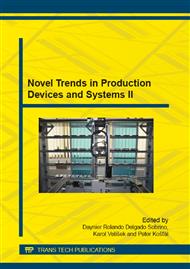p.201
p.207
p.213
p.219
p.225
p.231
p.237
p.243
p.247
Dividing the Complicated General Shapes of the Surface into Partial Elements According to Curvature (Gauss and Maximal Curvature) and its Multi-Axis Machining
Abstract:
The paper deals with multi-axis machining of complex shapes of freeform surfaces. Machining of such surfaces is very difficult and the critical operation is the optimal setting of tilt and lead angle which, along with other parameters, must ensure collision-free machining. This paper describes the possible dividing of solved freeform surface areas into partial elements with similar properties from CAD data using Matlab software instruments. The partition is solved by algorithms calculated according to the curvature of the surface using both methods the maximum and the Gaussian curvature. These partial elements can be machined separately which allows employment of tools with optimal dimensions for individual elements. This process enables significant reduction of tool-path necessary for machining these shapes which also leads to reduction of the working time. Furthermore, there are practical examples including a comparison of standard method and the use of machining process optimized by the algorithm in this article.
Info:
Periodical:
Pages:
225-230
Citation:
Online since:
December 2014
Authors:
Keywords:
Price:
Сopyright:
© 2014 Trans Tech Publications Ltd. All Rights Reserved
Share:
Citation:


